Lots of things are a pain
Have lots of different assembly sub-projects in the works at the moment. About 40 items on the to-do list left. Try to see them through, but often times they reach a frustrating point, and instead of getting aggravated and potentially causing a mess-up I’d regret later, the approach is to move to another project. That gives the subconscious time to work on the problem, maybe order a new tool or part that would help, and re-address it later when fresh.
Unfortunately after a while, you run out of stuff to switch to, and have to pick back up a frustrating aspect of the project. Here’s a brief rundown of some things causing frustration at the moment.
Power steering pump catastrophic leakage.
Spent a lot of time getting the power steering lines all cinched up, with the basic routing done. Poured in a couple ounces of the new Redline PS fluid, turned the wheel a bit (car in the air), all seemed fine. Added about half a quart. What’s that I hear? The PS fluid is streaming directly onto the floor! It’s not leaking from any of the fittings or orifices, it’s leaking from between the main pump body and the outer reservoir housing. No way to stop the leak, so I put the half full bottle of PS fluid back underneath and let it pour right back in. Used the above little lab bottle to collect the drips that continued for the next couple weeks, haven’t had the heart yet to get in there and undo all the painstakingly attached hoses. Need to get a new pump too.
Not hard to see how Donohue gave up on PS after only one or two races! It’s a lot of weight (20+ lbs.) and complexity, all up at the nose of the car, that also robs power. Just don’t think I can autocross this beast with a lot of caster without it though. Not and provide very precise driving inputs anyway.
Brake line fittings
This project has made me realize how easy most of my earlier car projects have been. Something as simple as brake lines, has been a big pain. The OE-style replacement hard lines don’t thread into the regular Wilwood calipers. Have to get a special adapter. Then there’s stuff like this one-
Have to figure out if it’s a bad fitting, mismatched threads, bad flex line, or something else, now after the system has some brake fluid in it. At least it’s a neat blue (ATE Superblue). Speaking of blue, took this photo of some oil. The LAT engine oil now in the car is a really fantastic blue color. Tried to capture it here by pouring a little in another bottle-
If you’ve ever seen the movie the Fifth Element, it looks just like blood from the Diva Plavalaguna after she gets shot. I’m sure that’s just what the oil engineers had in mind when they were blending it… 😉 Fortunately the engine oiling system is currently all set (though the pan install was not without its challenges), and doesn’t leak, now that an oil temp sender has been installed in the pan. Even have a dipstick now!
Leaf Springs
As noted back here, ride heights are all wrong at the moment. Front is relatively easy to adjust, with some turns of the Afco adjuster. Rear, not so much…variable height spacer blocks are available, but you don’t want to run any more spacer block than you have to.
The Hypercoil springs I first bought way back when are the only composite leafs they offer, and come with a 4.5″ “true arch”, whatever that mens. Of the many mistakes I’ve made in the progress of this project, one was assuming this would be a reasonable ride height. Turns out it is way way off, even with a 1″ spacer block. Car needed to be about 3″ lower from where it was with the Hypercoils, so the only real option was another set of springs. Liteflex LLC, who makes the springs for Hypercoil, didn’t return my message (their unit is a very high quality piece, despite the poor fitment for my application), so I called Flex-A-Form. With one call they were able to take my order. I wanted to replicate the Hypercoil specifications (spring rate and size), but be 3″ lower.
To their credit, they did get the springs to me relatively quickly, considering they had to be custom made. To their discredit, they weren’t going to offer anywhere near 3″ lower height than the Hypercoils. But again to their credit, they have an offset eye design in the spring end, which helps mitigate this – by disassembling the spring end and mounting it upside-down on the leaf, you can lower the effective mounting point by 1″ at one or both ends.
Looks easier than it is, they use a pretty aggressive glue to hold it on, making it some careful prying and chisel work to get the end off without hosing the fiberglass leaf. And the contours aren’t quite the same when upside-down so a bit of file work is required for it to fit right.
Once that’s done, I take a closer look at the Flex-A-Form leaf next to the Hypercoil, and realize that it is at least 2″ longer in the rear section. Ugg! So what do I do now, send them back? Will they take them back now that I’ve flipped the eyes? The more important question that came to mind was, what are the chances they even get it right the second time around, and what will continued messing about mean to the timeline? Instead, decided to modify them myself-
Marked and cut off the extra length; re-contoured the fiberglass to receive the spring eye; positioned eye (in the lowering upside-down orientation) and drilled holes for the mount bolts; cleaned it up, applied sealer/adhesive, and bolted it back together.
Then there’s the issue of bushings and bolt sleeves and washers and fasteners. John Coffey did a good job getting the Hypercoils mounted up way back when but had to custom-make a few pieces on his lathe to get it to go together. I don’t have a lathe or the raw materials, and thus had to improvise, cutting down and hogging out bushings to fit the larger sleeves John had made. *Nothing* about the springs just fit as delivered. Oh, and the subframe connectors have to be mostly removed to get the forward spring pockets out, which requires pulling apart a bunch of the interior.
What should have been a couple hours (swapping out rear springs for lower units) ended up taking at least 8, and only the first one is done! Other side should go faster but geez what a pain. Good news is, I should have all the info needed to get the next pair of Flex-A-Forms built right (I don’t expect the 250# spring rate I’m starting with, to be the one I stick with forever) so the work on the bushings and hardware should be re-usable on the next pair, making this swap only a couple hours, the sort of thing you might try between days at a multi-day race, with normal tools.
Road Draft Tube
Most people don’t even know what this is, and admittedly I didn’t either until recently.
In the old old days – like, before the Camaro – automakers had this thing called a “road draft tube”. They recognized that engines built up positive pressure in the crankcase, especially while the engine was working hard, and they had to figure out what to do with it. Without anywhere else to go, the pressure would cause oil to leak out past the seals, and make a mess of the car. So what they did, was run a tube from a port on the engine, down and back a ways, so liquid and mist oil escaping from the engine, would drip “harmlessly” on the road beneath the car. This was a significant contributor to the black stripe in the middle of our highway lanes; an intentional, built-in oil leak.
By the early 60’s people had begun realizing 1, this was bad for the environment, and 2, engines actually like a little bit of vacuum on this port – so what the heck, why don’t we just ingest this misty oily air and burn it in the combustion chamber? Thus the modern PCV system was born.
In the case of a ’67 Camaro V8, the road draft tube and PCV system are fairly basic. In the picture below (not my engine) you can see the “tomato can” – a very basic attempt at an air/oil separator – it is plumbed to the port on the block you see at the very top left.
From that port, a tube runs up and into the underside of the air cleaner lid. This provides a slight vacuum and causes oily badness to get sucked into the engine. This is actually not a good thing for combustion in a performance scenario, as it affects mixture in a negative way. Thus the benefit of catch cans, which are allowed in STX (even Stock) so long as the “original PCV function is retained”. Current plan is to run the road draft tube outlet to a catch can-slash-air/oil separator, which will then be plumbed back into the original place in the air cleaner. This should meet the rules while helping preserve healthy combustion.
So all of this ancient emission history is great, but what’s the problem? The problem is, the tube has this dome thing on it where it covers the port, where a single long bolt runs down through it, into female threads in the block. Since this probably makes for a common oil leak spot, somebody in the history of this block, must have overtightened the bolt, and it is now snapped off in that port, without enough meat protruding to get a tool on. The broken-off bolt has a nice dome shape to its top, making it tough to keep a drill bit centered, and it is recessed so far down there, normal bolt extractor bolts and tools can’t reach. Yay! As an added bonus, this is at the extreme rear of the block, so to even look at it, requires climbing into the engine bay and contorting one’s self, being careful not to mess up all the shiny, new, and sometimes delicate, engine parts.
I plan to give it a go with a traditional drill bit, and maybe see about extending the bolt extracting bit in some way, to get it down into the hole drilled. On a day when I’m feeling very patient and well rested… 🙂
Coolant Temp Sensor Port
The pristine intake manifold I bought from Jerry MacNeish two years ago now-
came with a plug in the port next to the thermostat housing mount, there on the right side. That port is used in ’67 Camaros for the coolant temperature sensor. In later years it was moved directly to the cylinder head.
I’ve tried penetrating fluid, tried heat, and even tried extreme force (ended up breaking the 1/2″ -> 3/8″ adapter), and nothing has been able to make that plug move. At this point it likely needs divine intervention, but in the meantime, have emailed Jerry asking for advice. Might try drilling it out, though I’m not enamored by the idea of the inevitable loose aluminum shavings floating around the cooling system.
On a related note, recently bought a complete tap and die kit. Not sure how I ever got along without it before, it’s been tremendously valuable.
Vent Windows
1967 was the only year the Camaro came with vent windows and as such, this is one area where replacement parts are hard to come by. And there are a whole lot of parts to replace! While I’m a big fan of the vent windows and like their classical elegance, from a technical standpoint, they are probably the least elegant things on the car. It takes an atrocious number of oddly shaped metal parts, contorted gaskets, and strange hardware, to make one of these vent windows work. Since some of the key stuff isn’t remanufactured, you have to make the best of what you can find. When it’s all said and done, it is heavy and makes you wonder why they even tried doing these things in the first place.
It’s not all cleaned up here, and the gasket still needs some trimming, but the driver’s side vent window is IN!

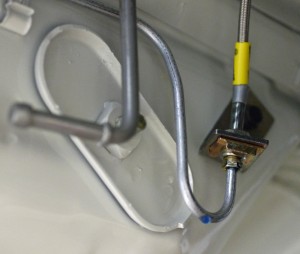
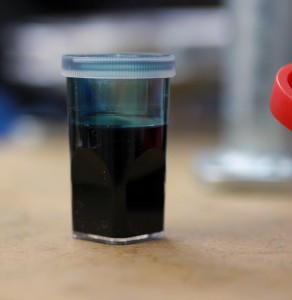
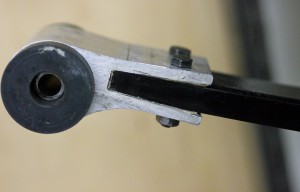
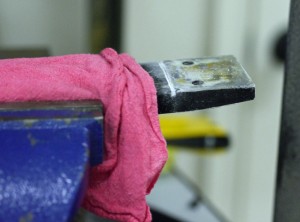
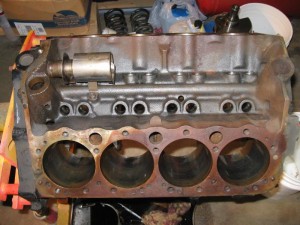
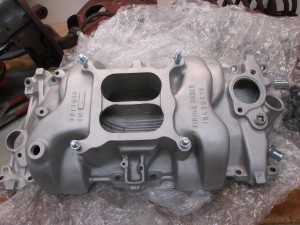
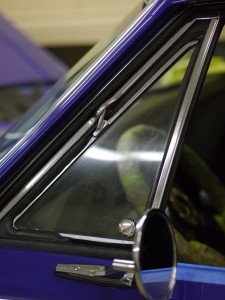
[…] a month ago I posted a list of stuck-points on the project – fortunately since then, with a lot of effort and tool purchases, progress has been made! Have […]